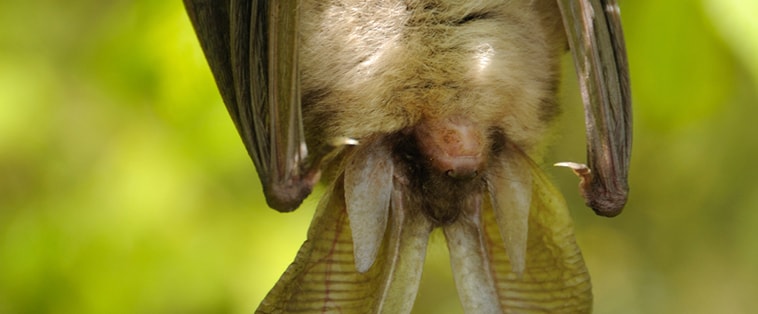At Southern Ecological Solutions (SES) we have a wealth of experienced ecologists that have conducted bat surveys followed by successful licensed mitigation schemes. These mitigation schemes are designed to meet clients ecological obligations and commercial needs in a cost effective and pragmatic way.
SES also has a specialist in house implementation team with expert ecological training allowing them to carry out works on sensitive sites. With experience in installing bat boxes, qualified tree climbing, sensitive tree felling and tree inspection.
To discuss your requirements please Contact us or call on 01268 711021.
UK Bat Habitat and Ecology
Over the last century bat populations have suffered serious declines and are currently under threat from factors such as the loss of feeding habitats and flight paths e.g. hedgerows, woodlands and ponds; loss of prey through the extensive use of pesticides having a detrimental effect on insect numbers and through building and developments destroying and damaging roost sites. To ensure the conservation of biodiversity it is recommended that developments adhere to regulations and that an appropriate ecological bat survey is conducted to assess the impact on bat populations.
Bats are the only true flying mammal, with their main source of food in Britain being insects, which they catch whilst in flight using echolocation. They use linear features such as hedgerows, tree lines, ditches and canals to navigate and feed along woodland edges, marshes, slow rivers and pasture. There are 17 bat species in Britain, the smallest being the Pipistrelle Pipistrellus spp. bat which weighs as little as 5g (same as £1 coin!) and the largest the Greater mouse eared bat Myotis myotis which can weigh up to 45g (which can still fit within the palm of your hand).
Bats are also becoming more reliant on urban habitats, where they roost in buildings and forage in nearby wooded parks and gardens. Habitat choice can be species-specific and some bats will journey further out to seek the habitat they prefer. Bats are loyal to certain roosting sites, but use different roosts at various times of the year; during the summer months females will seek out warmer sites such as bridges, trees and buildings in order to raise their young and conversely during the winter months both sexes roost in cooler structures with more stable temperatures.
Legal Status and Protection of Bats in the UK
Over the last century bat populations have suffered serious declines and are currently under threat from factors such as the loss of feeding habitats and flight paths e.g. hedgerows, woodlands and ponds; loss of prey through the extensive use of pesticides having a detrimental effect on insect numbers and through building and developments destroying and damaging roost sites.
Bats are protected under section 9 of the Wildlife and Countryside Act 1981 (as amended) and regulation 40 of theConservation of Habitats and Species Regulations 2010. Taken together it is illegal to:
– Deliberately kill, injure or capture any wild animal of European protected species;
– Deliberately disturb wild animals of any European protected species in such a way to be likely to significantly affect:
– The ability of any significant groups of animals of that species to survive, breed, rear or nurture their young; or
– The local distribution of that species.
– Recklessly disturb roosting bats or obstruct access to their roosts;
– Damage or destroys breed sites or resting places of such animals;
– Deliberately takes or destroys the eggs of such an animal;
– Possess or transport or any part of a European protected species, unless acquired legally;
– Sell, barter or exchange any part of a European protected species.
The maximum fine per offence is £5000 and if more than one bat is involved, £5000 per bat (Wildlife and Countryside Act 1981 Section 21). The Countryside and Rights of Way Act 2000 (CROW) amendment contains a provision for a custodial sentence of up to 6 months instead of, or in addition to, a fine. Along with a lengthy development delay until appropriate mitigation has been agreed and completed.
The Natural Environment and Rural Communities Act 2006 (NERC) also lists bats as a species of principle importance under Section 41 and Section 40 requires every public body in the exercising of its functions to ‘have regard, so far as is consistent with the proper exercise of those functions, to the purpose of conserving biodiversity’ . In addition, local authority planning departments should also meet the requirements of chapter 11: Conserving and enhancing the natural environment, of the Nation Planning Policy Framework; which requires planners to not only protect biodiversity, but where possible to enhance it.
Requirements of Bat Surveys
Any development that impacts upon bats requires survey work. Examples of development impacts include works on linear features such as woodland edges, hedgerows and canals nearby which bats may use for foraging. Felling old trees with crevices where bats can be found roosting, or demolishing/renovating buildings with suitable roosting features.
Bats are subject to strict legislation however some bat surveys do not require a licence; an experienced SES ecologist may carry out a dawn, dusk and activity survey without a licence.
However due to this strict legislation any work that requires ‘disturbance’ requires an appropriate Natural England licence to be carried by the bat worker. SES has experienced ecologists with appropriate licences to meet the needs of your project.
SES has ecologists that can provide the following essential bat surveys:
– Initial habitat assessment, an assessment of the potential of a site to support roosting, commuting and foraging bats.
– Building or bridge survey, SES licenced ecologists investigate buildings and bridges for bats or signs of bat use.
– Tree surveys, SES qualified tree climbers investigate trees for bats or signs of bat use.
– Underground site survey – ecologists with confined spaces training investigate underground sites for bats or signs of bat use.
– Dawn and dusk survey, SES ecologists watch for bats leaving and returning to their roosts respectively, allowing for the identification of roost sites. This provides confirmation of species identification, population estimates, roost status and access points.
– Bat activity survey, SES ecologists listen for bats commuting and foraging using bat detectors and recorders to enable analysis of bat echolocation calls, which are unique for each species.
Aerial Inspection for Bats – Bats often use cracks and holes in trees to roost and traditionally bat surveyors will only inspect trees from ground level using binoculars. In some cases this is adequate. Often holes which may look suitable for use by bats when viewed from the ground are not deep enough to be used when viewed up close.
Climbing the trees to get a closer view of any potentially suitable roosting features can enable the surveyor to discount features which may have seemed suitable from the ground, or to confirm the presence of bats so constraints are understood more quickly. An aerial inspection is an extremely effective and robust way of determining the presence or likely absence of bats, and is often much more effective than ground inspections and emergence surveys.
This means unnecessary survey can be avoided with a close aerial inspection as a single inspection can avoid 2-3 evening emergence surveys and can be undertaken throughout the year.
Bat Mitigation
After the completion of a bat survey an SES ecologist can assess the requirements for mitigation. An SES ecologist must hold a Natural England bat licence if a proposed development has any impact upon bats or their roosts and therefore a European Protected Species licence is required. Licence applications usually take Natural England around 30 days to process and adequate survey data therefore pre-planning is necessary to avoid any costly delays, which can run in to years without the proper planning.
SES ecologists have years of experience designing and implementing bat mitigation strategies in order to minimise the impact upon bat species and development respectively. Mitigation strategies vary but most successful examples are focused around how the developer can minimise harm towards bats by timing construction to avoid sensitive times such as May to late August when bats are breeding or from November to April during hibernation; as disturbance during this period can damage survival rates.
A constant in bat mitigation is the provision of bat roosting areas and/ or commuting and foraging grounds. This may range from the installation of bat boxes to the construction of a purpose built bat attic; commuting and foraging grounds can be satisfied with retention of specific vegetation and/or a replanting schemes.
Professional multi disciplinary service providing high quality cost effective Ecological Consultancy.



